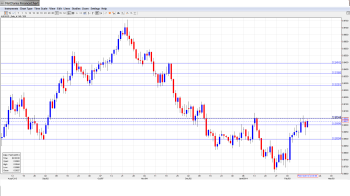AUD/USD posted weekly gains for the third consecutive time, climbing close to one cent last week. The pair closed slightly above the key 0.90 line. This week’s highlight is the RBA’s Monetary Policy Meeting Minutes. Here is an outlook on the major market-movers and an updated technical analysis for AUD/USD.
Australian Employment Change was a major disappointment, but the Aussie managed to shrug off the weak release. In the US, Unemployment Claims was above the estimate and retail sales numbers weakened in January, hurting the greenback.
[do action=”autoupdate” tag=”AUDUSDUpdate”/]AUD/USD graph with support and resistance lines on it. Click to enlarge:
- New Motor Vehicle Sales: Monday, 00:30. This indicator is an important gauge of consumer spending, as an increase in big-ticket items such as cars and trucks points to stronger consumer confidence and spending. The indicator rose a healthy 1.7% in the previous release.
- Monetary Policy Meeting Minutes: Tuesday, 00:30. The minutes provide a detailed report of the RBA’s most recent policy meeting. At the meeting, the RBA maintained rates but changed its stance on interest rates to neutral, and the Aussie shot higher in response. Analysts will be interested in reading the details of the meeting and the release could affect the movement of AUD/USD.
- CB Leading Index: Tuesday, 23:00. The index, which is based on 7 economic indicators, dipped to 0.2% last month, its weakest gain in three months. The markets will be hoping for a stronger figure in the upcoming release.
- Wage Price Index: Wednesday, 00:30. Wage Price Index is an important gauge of consumer inflation. It is released each quarter, magnifying the impact of each release. The index weakened in Q3, posting a gain of 0.5%, which was short of the estimate of 0.8%. The estimate for Q4 stands at 0.7%.
- Chinese Flash Manufacturing PMI: Thursday, 1:45. Key Chinese data such as PMIs can affect AUD/USD, since China is Australia’s number one trading partner. Manufacturing PMI slipped to 49.6 points in December, the first time it has been below the 50-point level since last June, short of the estimate of 50.6 points. A reading below 50 points to contraction in the industry. The markets are expecting another weak reading, with the estimate standing at 49.4 points.
*All times are GMT.
AUD/USD Technical Analysis
AUD/USD started the week at 0.8944 and then touched a low of 0.8907, as support at 0.8893 (discussed last week) remained firm. The pair then reversed directions, pushing past the 0.90 line and touching a high of 0.9067. The pair closed the week at 0.9027.
Technical lines from top to bottom:
We start with resistance at 0.9442. This marked the high point of the pair in November, which saw the Aussie go on a sharp slide and drop below the 0.89 line. This is followed by resistance at 0.9368, which was an important line in mid-November.
Next, there is resistance at 0.9283. This line saw a lot of action in the months of June and July, alternating between resistance and support roles. It has provided steady resistance since November.
0.9180 follows. It is followed by the round number of 0.9000, which was breached as the Aussie pushed higher. It starts the week as weak resistance.
0.8893 held firm in a support role. It has some breathing room as the Australian dollar trades above the 0.90 line.
0.8728 continues to provide strong support.
This is followed by 0.8578, which has remained intact since July 2010.
The final support level for now is 0.8432, which played a key support role in late 2009.
I am neutral on AUD/USD.
The Aussie had another good week, and is back above the 0.90 level. However, the RBA wants to see the currency trading at lower levels, so we could hear RBA officials try to “talk down” the Australian dollar. In the US, employment numbers remain a concern, but the markets are content with the general direction of the US economy.
- For a broad view of all the week’s major events worldwide, read the USD outlook.
- For EUR/USD, check out the Euro to Dollar forecast.
- For the Japanese yen, read the USD/JPY forecast.
- For GBP/USD (cable), look into the British Pound forecast.
- For the Australian dollar (Aussie), check out the AUD to USD forecast.
- USD/CAD (loonie), check out the Canadian dollar.

